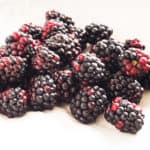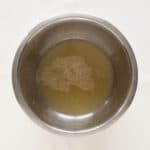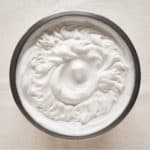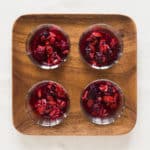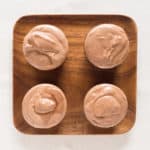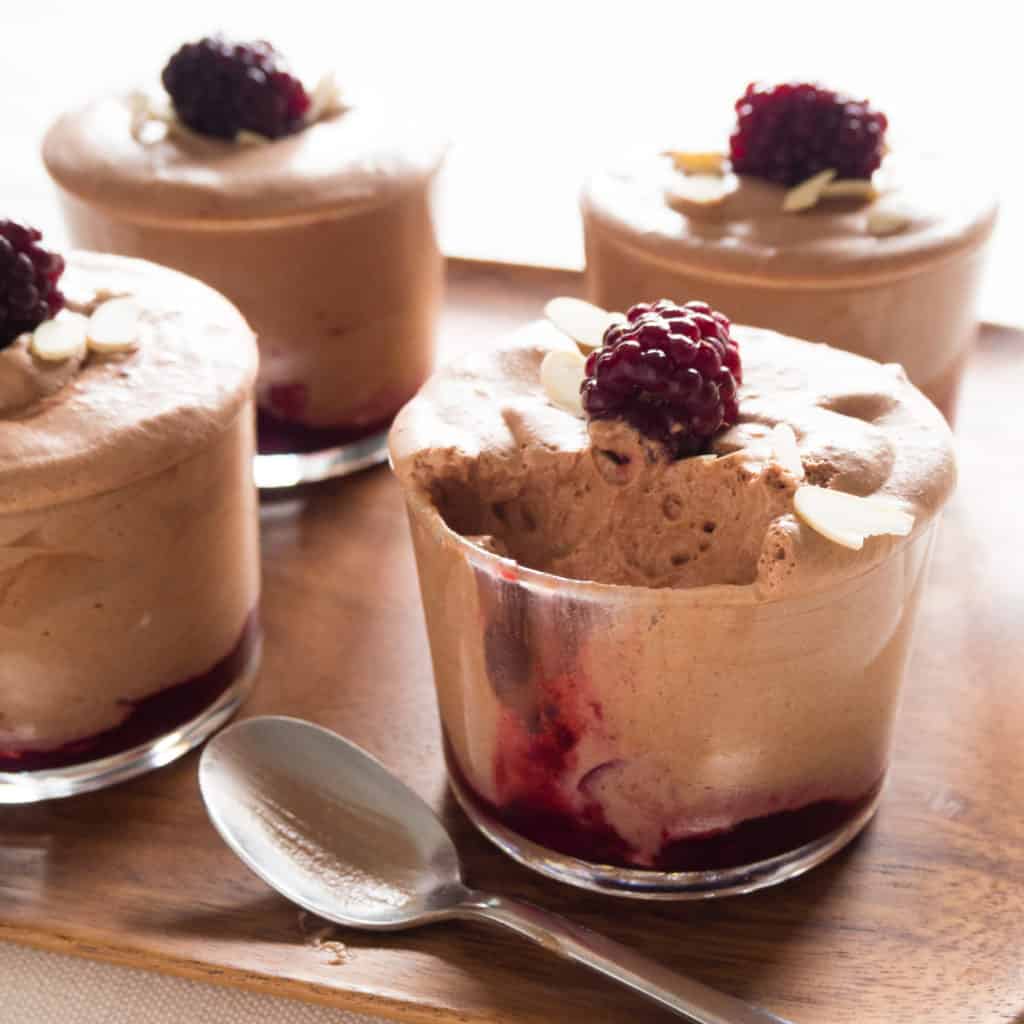
Blackberry and Almond Chocolate Mousse is one of those stop-in-your-tracks, take-a-pause, desserts. And it is gluten-free and vegan. Wonderful seasonal blackberries marry perfectly with slightly crunchy toasted almonds and a super-light, dark chocolate mousse.
Blackberry and Almond Chocolate Mousse is quick and medium difficulty to make but takes time to set in the fridge.
You can find the full Blackberry and Almond Chocolate Mousse recipe here.
Perfect for any special occasion (or none!). Blackberry and Almond Chocolate Mousse needs no accompaniment. It is however, a great dessert to follow Grilled Nectarine Salad with Rocket and Walnuts or Winter Vegetable Salad With Walnut Dressing.
Top tip. When you think the chickpeas juice is sufficiently whipped carry on!!! It is really important to beat the chickpea juice until it is really, really stiff, and then beat it some more. The mixture should hold its shape completely and not move at all when the bowl is shaken. This can take quite some time.
Top tip. The chickpea juice will also triple in volume so ensure you have a large enough bowl.
Top tip. I recommend an electric whisk for the chickpea juice. It will take forever by hand.
Top tip. You can get vegan dark chocolate in most supermarkets (in the ‘normal’ sweet isle or the ‘free from’ section depending upon the store) or in wholefood/ healthfood shops. Make sure you get a 70% cocoa solids chocolate that is quite bitter. Otherwise the mouse will be super-sweet.
Preparation
Difficulty medium
Preparation time 30 minutes
Cooking time 0 minutes (takes one to two hours to set in the fridge)
You can find the full Blackberry and Almond Chocolate Mousse recipe here.
Allergens
Blackberry and Almond Chocolate Mousse is gluten-free and vegan as well as…
Celery free
Coconut free
Garlic free
Lupin free
Mustard free
Nightshade free
Onion free
Peanut free
Sesame free
Soya free
What’s the Deal with Blackberries?
I adore blackberries, although they signify the end of summer and the start of autumn they remind me of days out with my dad, when I was really young, picking blackberries and eating as many as I could. Blackberries are so accessible (you can get them for free from hedgerows across the country) and so versatile I just can’t get enough of them.
What are blackberries?
The blackberry is an edible fruit produced by numerous species of the Rubus genus in the Rosaceae family. The taxonomy of blackberries has historically been confused because of hybridisation. Species have often been grouped together and called species aggregates. It is a widespread and well-known group of over 375 species, many of which are closely related apomictic microspecies native throughout Europe, northwestern Africa, temperate western and central Asia and North and South America.
The black, or dark purple, fruit is not a true berry in the botanical sense. Botanically it is termed an aggregate fruit, composed of small drupelets (the tiny, delicious, elements that together with seeds form the blackberry).
The blackberry is related to the raspberry and is distinguished from the raspberry by whether or not the torus (stem) “picks with” the fruit. When a blackberry fruit is picked, the torus does stay with the fruit. With a raspberry, the torus remains on the plant, leaving a hollow core in the raspberry fruit.
The term bramble, particularly in Scotland and the north of England, is often used to describe the blackberry or its products (e.g. jam). In the United States the term bramble applies to all members of the Rubus genus. In the western US, the term caneberry is used to refer to blackberries and raspberries as a group rather than the term bramble. Generally the term bramble is used to describe the plant and its voracious and viscous tendrils.
Origins and spread of blackberries
The blackberry is native to northern Europe and grows wild across the continent. The blackberry as been cultivated since the 16th century. The blackberry and was introduced to north and south America, Australia, New Zealand and China where it is cultivated.
Blackberries or brambles are often thought of as a weed as the plant sends down roots from branches that touch the ground and sends up suckers from the roots. The plant is very spiky and very difficult to get rid of. In some parts of the world without native blackberries, such as in Australia, Chile, New Zealand, and the Pacific Northwest of North America, some blackberry species are naturalised and considered an invasive species and a serious weed.
What do you do with blackberries?
Blackberries are a favourite fruit for lots and lots of desserts. They are often a little tarts and lend themselves well as an accompaniment in sweet desserts. Apple and blackberry crumble is a traditional favourite. Also popular in cobblers, cakes and muffins. Blackberry jam is incredibly popular. The tart nature of blackberries makes them a great savoury side, in much the same way as apple sauce is used along side a roast.
Nutritional value of blackberries
Cultivated blackberries contain significant contents of dietary fibre, vitamin C, and vitamin K. A 100 gram serving of raw blackberries supplies 43 kilo-calories and 5 grams of dietary fibre or 25% of the recommended RDA. In 100 grams, vitamin C and vitamin K contents are 25% and 19% RDA, respectively, while other essential nutrients are low in content.
Blackberries contain numerous large seeds (often disliked as they stick in your teeth!). The seeds contain oil rich in omega-3 (alpha-linolenic acid) and -6 fats (linoleic acid) as well as protein, dietary fiber, carotenoids, ellagitannins and ellagic acid.
What’s the Deal with Almonds?
Almonds are fabulous in sweet and savoury food and as a snack (plain, toasted, roasted salted…). We are lucky enough to have an almond tree outside our house and as well and the wonderful, bountiful, fresh nuts it gives us we have an extra treat in spring when the tree blossoms and looks wonderful.
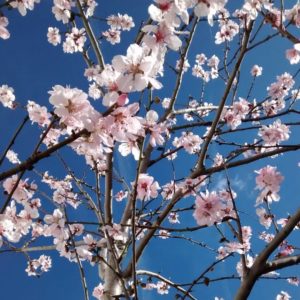
What are almonds?
The almond (Prunus dulcis, syn. Prunus amygdalus) is a species of tree native to the Middle East, the Indian subcontinent and North Africa. “Almond” is also the name of the edible and widely cultivated seed of this tree. Within the genus Prunus, it is classified with the peach in the subgenus Amygdalus.
The fruit of the almond is a drupe, consisting of an outer hull and a hard shell with the seed, which is not a true nut, inside. Shelling almonds refers to removing the shell to reveal the seed. Almonds are sold shelled or un-shelled. Blanched almonds are shelled almonds that have been treated with hot water to soften the seed-coat, which is then removed to reveal the white embryo.
The almond is a deciduous tree, growing 4–10 metres in height, with a trunk of up to 30 centimetres in diameter. The flowers are white to pale pink, 3–5 cm diameter with five petals, produced singly or in pairs and appearing before the leaves in early spring. Almond grows best in Mediterranean climates with warm, dry summers and mild, wet winters. The optimal temperature for their growth is 15-30 C and the tree buds have a chilling requirement of 300 to 600 hours below 7.2 C to break dormancy.
Origins and spread of almonds
The almond is native to the Mediterranean climate region of the Middle East, eastward as far as the Yamuna River in India. It was spread by humans in ancient times along the shores of the Mediterranean into northern Africa and southern Europe, and more recently transported to other parts of the world, notably California, United States.
The wild form of domesticated almond grows in parts of the Levant. The wild (bitter) almond is poisonous. The fruit of the wild forms contains the glycoside amygdalin, which becomes hydrogen cyanide after crushing, chewing, or any other injury to the seed. Selection of the sweet type from the many bitter types in the wild marked the beginning of almond domestication. It is not clear which wild ancestor of the almond created the domesticated species.
Domesticated almonds appear in archaelogical sites from the Early Bronze Age (3000–2000 BC) and possibly a little earlier. Almond fruit was found in Tutankhamun’s tomb in Egypt (c. 1325 BC).
What do you do with almonds?
Almonds are often eaten as a snack, raw, raosted or toasted. However, they are also used as an ingredient in a variety of dishes. Almonds work equally well in sweet and savoury foods.
Almonds are available in many forms: whole, flaked, slivered, roasted, toasted, ground. Almond oil can be pressed and used in cooking skincare. Almonds are widely used acorss the world in a huge variety of pastries, biscuits, and cakes and other sweets and desserts. Almond essence is often used in baking. They are also used to make almond butter, similar to peanut butter, popular with peanut allergy sufferers. Almonds can be used to make almond butter or almond milk (very popular dairy-milk alternative).
Marzipan is probably the most well known (and often furiously disliked) single use of almonds. A marzipan layer on cakes is loved as often as it is peeled-off and cast aside!
Nutritional value of almonds
The almond is a nutritionally dense food. A 100 gram serving of raw almonds provides 576 kilo-calories, >20% RDA of the B vitamins riboflavin and niacin, vitamin E, and the essential minerals calcium, iron, magnesium, manganese, phosphorus, and zinc. 100 grams of raw almonds is also a good source (10–19% RDA) of thiamine, vitamin B6, folate, choline and potassium. Almonds are rich in dietary fibre, monounsaturated fats, and polyunsaturated fats. Typical of nuts and seeds, almonds also contain phytosterols such as beta-sitosterol, stigmasterol, campesterol, sitostanol, and campestanol.
